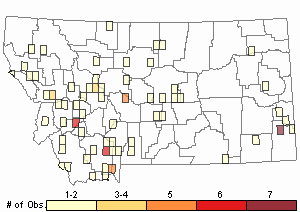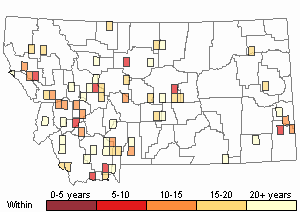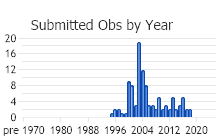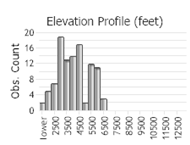View in other NatureServe Network Field Guides
NatureServe
Montana
Utah
Wyoming
Idaho
Wisconsin
British Columbia
South Carolina
Yukon
California
New York
A Diatom - Cymbella mexicana
General Description
Morphological Category - Asymmetric biraphid.
Valves large, attached to substrates by polysaccharide stalks. Dorsal margin strongly arched; ventral margin slightly concave with a tumid center. Apices broadly rounded.
Axial Area narrow;
Central Area small, rounded. One stigma present between the proximal raphe ends.
Raphe branches lateral at their centers, narrowing towards the proximal and distal ends. Proximal raphe ends dilated. Terminal raphe fissures dorsally deflected nearly 90 degrees. Apical pore fields present at both apices.
Striae radiate near the valve center, becoming parallel near the ends. Striae surrounding the central area alternately long and short.
Areolae distinct, circular to squared, 9 to 12 in 10 µm. Areolae triangular adjacent to the axial and central areas.
Size RangeLength 63–200 µm.
Width 23–45 µm.
Striae in 10 µm 6–9.
Stigmata 1.
Useful Link:
Diatom Glossary [Diatoms of North America website]
Diagnostic Characteristics
Cymbella mexicana is distinguished from
Cymbella janischii by its smaller size, more widely spaced striae and lack of strongly elongated areolae adjacent to the central area.
Range Comments
Locally common and widely distributed across western North America.
Number of Observations in Montana Diatom Collection Database (Bahls 1968-2019): 720; Montana: 501.
Observations in Montana Natural Heritage Program Database
Number of Observations: 106
(Click on the following maps and charts to see full sized version)
Map Help and Descriptions
Relative Density

Recency



 (Observations spanning multiple months or years are excluded from time charts)
(Observations spanning multiple months or years are excluded from time charts)
Habitat
Rivers and creeks.
Ecology
Cymbella mexicana is one of several large cymbelloid diatoms that form conspicuous growths in streams. This group includes Cymbella janischii and Didymosphenia geminata. Frustules extrude a mucous-like polysaccharide through an apical pore field at one pole, which quickly hardens to form a stalk by which frustules attach to a firm substrate and to the rest of the colony. Colonies of branched stalks with frustules at their ends may reach several cm in diameter, appear as “dirty cotton balls” in the water, cover large areas of substrate and generate complaints from the public (Bahls 2007).
Water Chemistry
Cool, alkaline waters with low to moderate nutrients and conductivity. Abundance-weighted mean values for selected water quality variables: conductivity = 1420 µS/cm; pH = 8.2; water temperature = 12.3 degrees C; total nitrogen = 0.500 mg/L; total phosphorus = 0.047 mg/L.
Reproductive Characteristics
Diatoms typically reproduce by cell division (mitosis) and occasionally by meiosis—sexual reproduction in which female and male gametes combine to form a specialized zygote called an auxospore. Repeated divisions result in cells of a population becoming progressively smaller and smaller. When cells reach a critically small size, sexual reproduction is initiated, resulting in an auxospore and initial cells that are the largest attainable for the species, after which cell division and size reduction resume (Amato 2010).
Stewardship Responsibility
References
- Literature Cited AboveLegend:
 View Online Publication
View Online Publication Amato, A. 2010. Diatom reproductive biology: living in a crystal cage. The International Journal of Plant Reproductive Biology 2(1): 1-10.
Amato, A. 2010. Diatom reproductive biology: living in a crystal cage. The International Journal of Plant Reproductive Biology 2(1): 1-10.
- Additional ReferencesLegend:
 View Online Publication
View Online Publication
Do you know of a citation we're missing? Foris, W.J. 1976. A comparison of diatoms on horizontal and vertical substrates in Georgetown Lake, Montana. M.Sc. Thesis. Bozeman, MT: Montana State University. 98 p.
Foris, W.J. 1976. A comparison of diatoms on horizontal and vertical substrates in Georgetown Lake, Montana. M.Sc. Thesis. Bozeman, MT: Montana State University. 98 p. Gumtow, R.B. 1954. An investigation of the periphyton in a riffle of the West Gallatin River, Montana. M.Sc. Thesis. Bozeman, MT: Montana State University. 29 p.
Gumtow, R.B. 1954. An investigation of the periphyton in a riffle of the West Gallatin River, Montana. M.Sc. Thesis. Bozeman, MT: Montana State University. 29 p. Roeder, T. 1966. Ecology of the diatom communities of the upper Madison River system, Yellowstone National Park. Ph.D. Dissertation. Bozeman, MT: Montana State University. 67 p.
Roeder, T. 1966. Ecology of the diatom communities of the upper Madison River system, Yellowstone National Park. Ph.D. Dissertation. Bozeman, MT: Montana State University. 67 p.
- Web Search Engines for Articles on "A Diatom"





